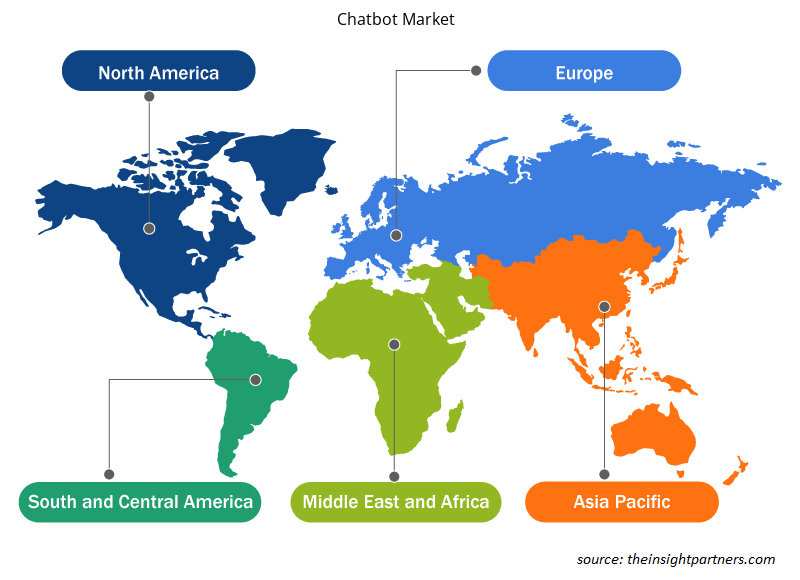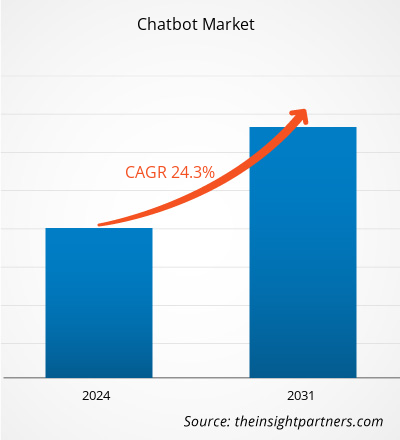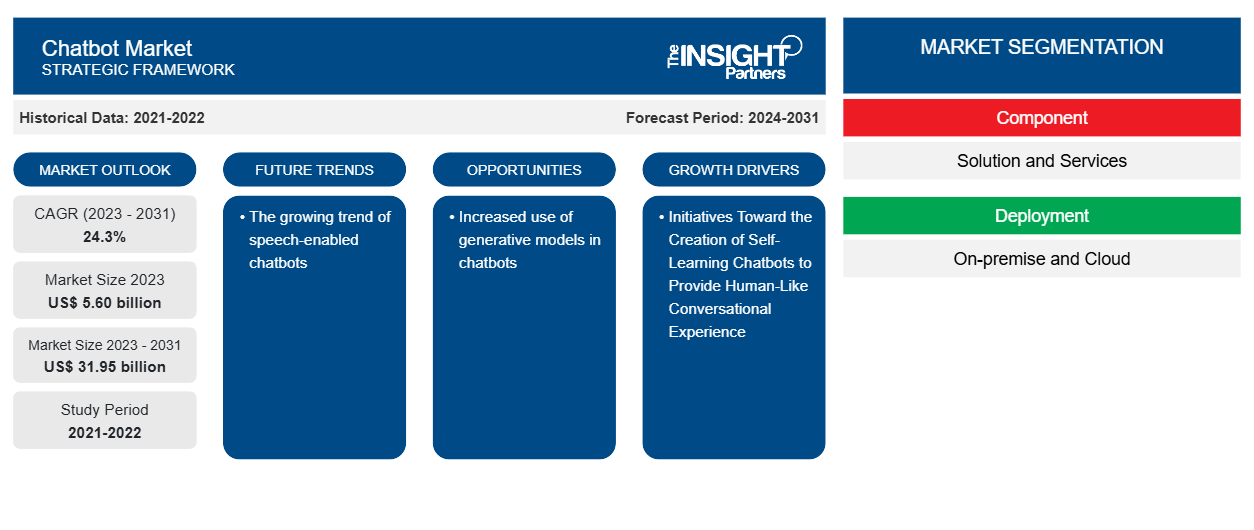Der Chatbot-Markt soll von 5,60 Milliarden US-Dollar im Jahr 2023 auf 31,95 Milliarden US-Dollar im Jahr 2031 anwachsen. Der Chatbot-Markt wird voraussichtlich zwischen 2023 und 2031 eine durchschnittliche jährliche Wachstumsrate von 24,3 % verzeichnen. Der Markt wird vor allem durch die zunehmende Dominanz von Messenger-Anwendungen und die steigende Nachfrage nach Kundenanalysen angetrieben.
Chatbot-Marktanalyse
Generative Modelle können die Fähigkeiten von Chatbots zur Verarbeitung natürlicher Sprache (NLP) verbessern, was zu einem besseren Verständnis und einer besseren Reaktion auf menschliche Sprache führt. Generative Modelle wie GPT-4 können das Verständnis von Chatbots für Benutzerpräferenzen und -gewohnheiten verbessern und so maßgeschneiderte Empfehlungen und Unterstützung ermöglichen. Aufgrund der wachsenden Beliebtheit von Messenger-Anwendungen bringt die Integration von Chatbots in Messenger eine höhere Kapitalrendite, da die Ansprache von Kunden über ihre bevorzugte Anwendung das Benutzererlebnis verbessert.
Chatbot-Marktübersicht
Der Chatbot-Markt ist in den letzten Jahren stark gewachsen. Die Notwendigkeit, rund um die Uhr Kundenservice zu bieten und die Betriebskosten durch die Delegierung von Aufgaben an Chatbots zu senken, sowie der steigende Wunsch der Kunden nach Selbstbedienungsvorgängen haben zu einer erhöhten Nachfrage beigetragen. Dies kann mit der zunehmenden Vorliebe der Menschen für Messaging-Anwendungen gegenüber sozialen Netzwerken zusammenhängen. Chatbots, die für die Integration mit Messaging-Apps entwickelt wurden, werden in Zukunft voraussichtlich ebenfalls eine hohe Marktnachfrage erfahren. Darüber hinaus erfreuen sich Chatbots wachsender Beliebtheit, da Unternehmen bestrebt sind, ihren Vertrieb und ihre Kundenbetreuung zu automatisieren. Der Einsatz von Chatbots ermöglicht es Unternehmen, zeitnahe Dienste zu geringeren Kosten bereitzustellen.
Passen Sie diesen Bericht Ihren Anforderungen an
Sie erhalten kostenlose Anpassungen an jedem Bericht, einschließlich Teilen dieses Berichts oder einer Analyse auf Länderebene, eines Excel-Datenpakets sowie tolle Angebote und Rabatte für Start-ups und Universitäten.
-
Holen Sie sich die wichtigsten Markttrends aus diesem Bericht.Dieses KOSTENLOSE Beispiel umfasst eine Datenanalyse von Markttrends bis hin zu Schätzungen und Prognosen.
Treiber und Chancen auf dem Chatbot-Markt
Verstärkter Einsatz generativer Modelle in Chatbots zur Förderung des Marktes
KI hat in letzter Zeit erhebliche Entwicklungen erfahren, insbesondere im Bereich generative KI und LLMs. Auf Deep Learning basierende Modelle generieren frischen Inhalt, indem sie Muster in riesigen Datensätzen erkennen. Der Chatbot von OpenAl, ChatGPT, verwendet das Sprachmodell GPT-3.5, um menschenähnliche Prosa zu generieren, die den Kontext erkennt. Neben Text-zu-Text kann generative KI auch Bilder, Videos , 3D-Modelle, Musik und mehr konvertieren. Generative KI ermöglicht es Unternehmen, schneller und effizienter einzigartige Ideen für Produkte, Dienstleistungen und Lösungen zu entwickeln. Generative KI liefert Organisationen datengesteuertes Wissen für fundierte Entscheidungen und reduziert die mit Produktentwicklungs- und Marketingzyklen verbundenen Kosten.
Initiativen zur Entwicklung selbstlernender Chatbots für ein menschenähnliches Gesprächserlebnis
Chatbots können sich an veränderte Umgebungen anpassen und aus ihren Aktionen, Erfahrungen und Schlussfolgerungen lernen. Chatbots analysieren Daten schnell und bieten Support in vielen Sprachen, sodass Kunden die benötigten Informationen leichter finden können. Selbstlernende Bots verwenden datengesteuertes Verhalten, NLP-Technologie und überwachtes maschinelles Lernen, um eine natürlichere Kommunikation zu ermöglichen. Sie können aus ihren Fehlern lernen. Es laufen mehrere Anstrengungen zur Entwicklung selbstlernender Chatbots. Selbstlernende Chatbots bieten personalisierte und angemessene Antworten und verbessern so das Verbrauchererlebnis. Der Chatbot lernt kontinuierlich aus Benutzerinteraktionen.
Chatbot-Marktbericht – Segmentierungsanalyse
Wichtige Segmente, die zur Ableitung der Chatbot-Marktanalyse beigetragen haben, sind Komponente, Bereitstellung, Größe der Nutzungsorganisation und Endbenutzer.
- Basierend auf den Komponenten ist der Chatbot-Markt in Lösungen und Dienste segmentiert.
- Basierend auf der Bereitstellung ist der Chatbot-Markt in On-Premise und Cloud segmentiert.
- Basierend auf der Nutzung ist der Chatbot-Markt in Websites, Contact Center, soziale Medien und mobile Plattformen segmentiert.
- Basierend auf dem Endbenutzer ist der Chatbot-Markt in Bildung, Einzelhandel und E-Commerce, BFSI, Gesundheitswesen, Reisen und Tourismus und Andere segmentiert.
Chatbot-Marktanteilsanalyse nach Geografie
Der geografische Umfang des Chatbot-Marktberichts ist hauptsächlich in fünf Regionen unterteilt: Nordamerika, Asien-Pazifik, Europa, Naher Osten und Afrika sowie Südamerika/Süd- und Mittelamerika. Der Asien-Pazifik-Raum erlebt eine enorme Industrialisierung, was die Nachfrage nach Chatbots auf dem Markt erhöht. Die wachsenden Einzelhandels- und E-Commerce-Branchen in aufstrebenden Ländern wie China, Indien, Indonesien, Vietnam, Malaysia, den Philippinen und Thailand haben die hohe Nachfrage und breite Akzeptanz von Chatbots bei Händlern und E-Commerce- Firmeninhabern beschleunigt.
Regionale Einblicke zum Chatbot-Markt
Die regionalen Trends und Faktoren, die den Chatbot-Markt im Prognosezeitraum beeinflussen, wurden von den Analysten von Insight Partners ausführlich erläutert. In diesem Abschnitt werden auch Chatbot-Marktsegmente und -Geografie in Nordamerika, Europa, im asiatisch-pazifischen Raum, im Nahen Osten und Afrika sowie in Süd- und Mittelamerika erörtert.

- Holen Sie sich regionale Daten zum Chatbot-Markt
Umfang des Chatbot-Marktberichts
| Berichtsattribut | Details |
|---|---|
| Marktgröße im Jahr 2023 | 5,60 Milliarden US-Dollar |
| Marktgröße bis 2031 | 31,95 Milliarden US-Dollar |
| Globale CAGR (2023 - 2031) | 24,3 % |
| Historische Daten | 2021-2022 |
| Prognosezeitraum | 2024–2031 |
| Abgedeckte Segmente |
Nach Komponente
|
| Abgedeckte Regionen und Länder |
Nordamerika
|
| Marktführer und wichtige Unternehmensprofile |
|
Dichte der Chatbot-Marktteilnehmer: Die Auswirkungen auf die Geschäftsdynamik verstehen
Der Chatbot-Markt wächst rasant, angetrieben durch die steigende Nachfrage der Endnutzer aufgrund von Faktoren wie sich entwickelnden Verbraucherpräferenzen, technologischen Fortschritten und einem größeren Bewusstsein für die Vorteile des Produkts. Mit steigender Nachfrage erweitern Unternehmen ihr Angebot, entwickeln Innovationen, um die Bedürfnisse der Verbraucher zu erfüllen, und nutzen neue Trends, was das Marktwachstum weiter ankurbelt.
Die Marktteilnehmerdichte bezieht sich auf die Verteilung der Firmen oder Unternehmen, die in einem bestimmten Markt oder einer bestimmten Branche tätig sind. Sie gibt an, wie viele Wettbewerber (Marktteilnehmer) in einem bestimmten Marktraum im Verhältnis zu seiner Größe oder seinem gesamten Marktwert präsent sind.
Die wichtigsten auf dem Chatbot-Markt tätigen Unternehmen sind:
- Amazon Web Services
- Künstliche Lösungen
- Creative Virtual Pvt. GmbH.
- CX-Unternehmen
- eGain Corporation
- IBM Corporation
Haftungsausschluss : Die oben aufgeführten Unternehmen sind nicht in einer bestimmten Reihenfolge aufgeführt.

- Überblick über die wichtigsten Akteure auf dem Chatbot-Markt
Neuigkeiten und aktuelle Entwicklungen zum Chatbot-Markt
Der Chatbot-Markt wird durch die Erhebung qualitativer und quantitativer Daten nach Primär- und Sekundärforschung bewertet, die wichtige Unternehmenspublikationen, Verbandsdaten und Datenbanken umfasst. Im Folgenden finden Sie eine Liste der Entwicklungen auf dem Markt:
- Im April 2023 ging Zendesk eine Partnerschaft mit OpenAI ein, einem führenden KI-Forschungslabor mit Sitz in Amerika. Das Unternehmen würde seinen Benutzern KI-gestützte Lösungen zur Verfügung stellen, um die Ticketerstellung für CX- und Kundendienstmitarbeiter zu vereinfachen. Zendesk und OpenAI arbeiten zusammen, um die Funktionen der proprietären Basismodelle von Zendesk zu verbessern, indem sie diese mit denen von OpenAI integrieren.
(Quelle: Zendesk, Pressemitteilung, 2021)
- Kore.ai gab bekannt, dass es im Januar 2023 auf der Ausstellung der National Federation of Retailers (NRF 2023) in New York City RetailAssist vorstellen wird, eine Konversations-Verkaufsassistentenlösung für den Einzelhandel.
(Quelle: Kore.ai, Pressemitteilung, 2023)
Bericht zum Chatbot-Markt – Umfang und Ergebnisse
Der Bericht „Chatbot-Marktgröße und -prognose (2021–2031)“ bietet eine detaillierte Analyse des Marktes, die die folgenden Bereiche abdeckt:
- Marktgröße und Prognose auf globaler, regionaler und Länderebene für alle wichtigen Marktsegmente, die im Rahmen des Projekts abgedeckt sind
- Marktdynamik wie Treiber, Beschränkungen und wichtige Chancen
- Wichtige Zukunftstrends
- Detaillierte PEST/Porters Five Forces- und SWOT-Analyse
- Globale und regionale Marktanalyse mit wichtigen Markttrends, wichtigen Akteuren, Vorschriften und aktuellen Marktentwicklungen
- Branchenlandschaft und Wettbewerbsanalyse, einschließlich Marktkonzentration, Heatmap-Analyse, prominenten Akteuren und aktuellen Entwicklungen
- Detaillierte Firmenprofile
- Historische Analyse (2 Jahre), Basisjahr, Prognose (7 Jahre) mit CAGR
- PEST- und SWOT-Analyse
- Marktgröße Wert/Volumen – Global, Regional, Land
- Branchen- und Wettbewerbslandschaft
- Excel-Datensatz
Aktuelle Berichte
Erfahrungsberichte
Grund zum Kauf
- Fundierte Entscheidungsfindung
- Marktdynamik verstehen
- Wettbewerbsanalyse
- Kundeneinblicke
- Marktprognosen
- Risikominimierung
- Strategische Planung
- Investitionsbegründung
- Identifizierung neuer Märkte
- Verbesserung von Marketingstrategien
- Steigerung der Betriebseffizienz
- Anpassung an regulatorische Trends























 Kostenlose Probe anfordern für - Chatbot-Markt
Kostenlose Probe anfordern für - Chatbot-Markt